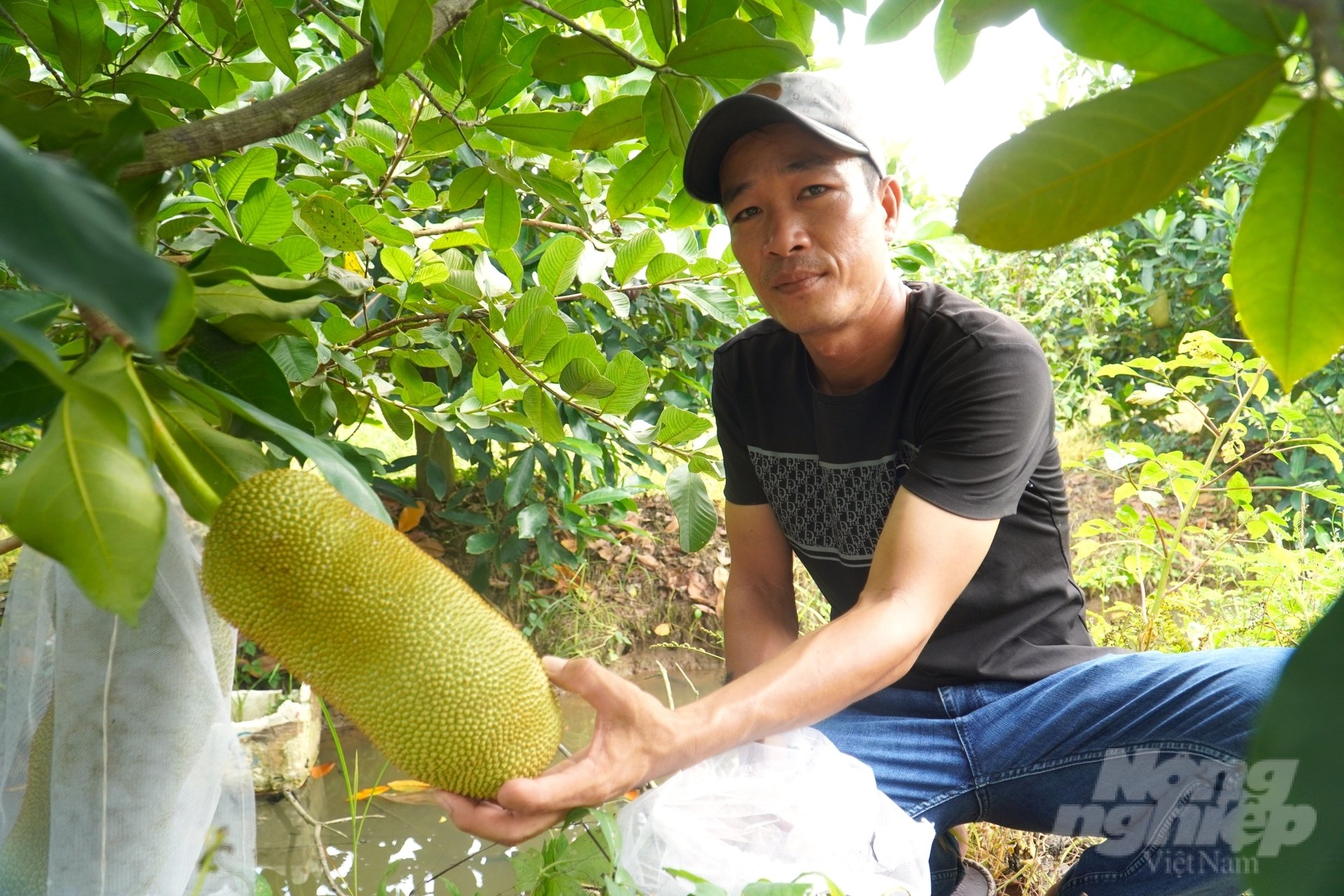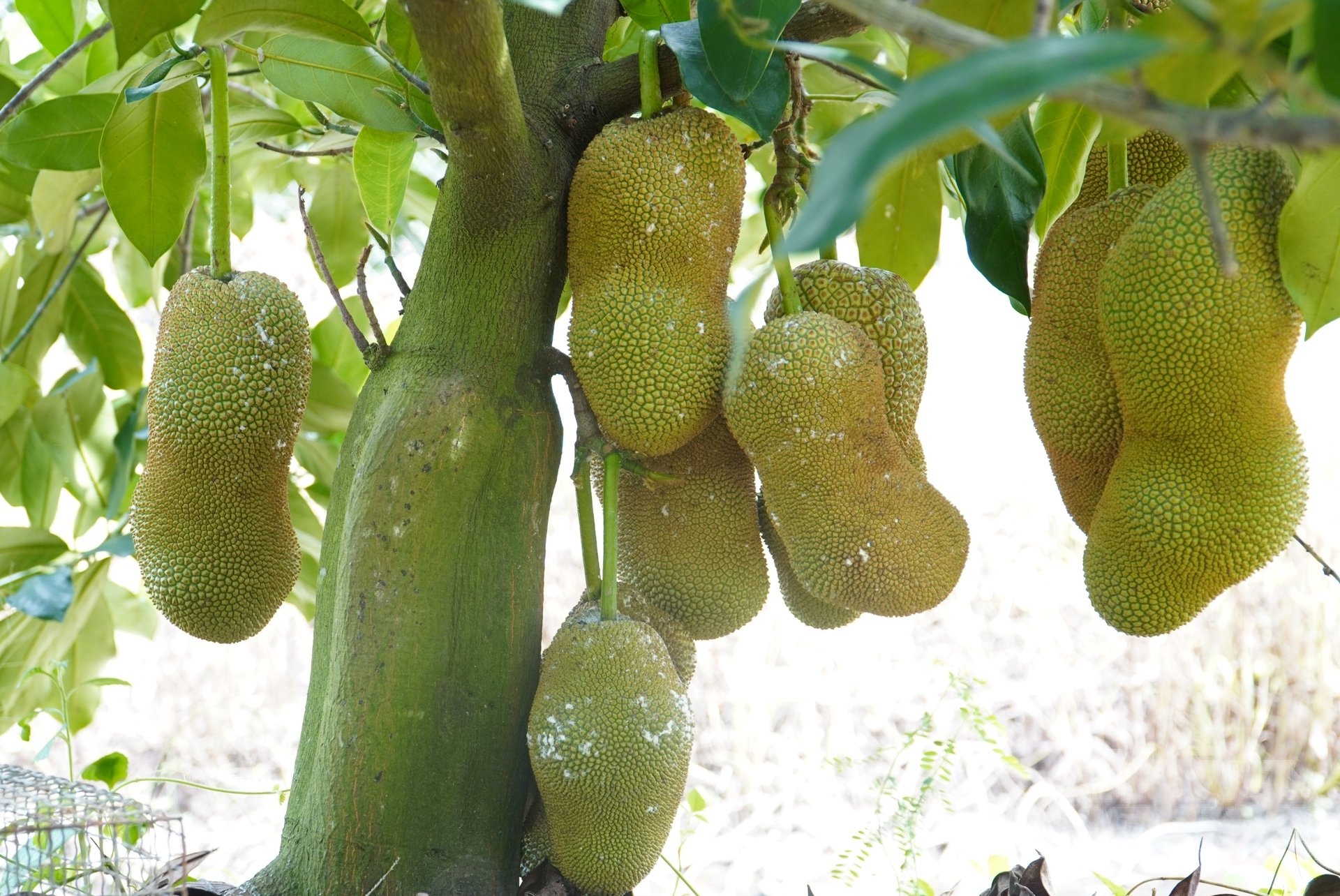November 26, 2025 | 05:50 GMT +7
November 26, 2025 | 05:50 GMT +7
Hotline: 0913.378.918
November 26, 2025 | 05:50 GMT +7
Hotline: 0913.378.918
Recently, the rare and unique jackfruit variety with the flavor of a durian created by Mr. Nguyen Huu Khang in Tan Loc Ward, Thot Not District, Can Tho City has gained attention from many gardeners and local farmers.

The Sub-Department of Cultivation and Plant Protection of Can Tho highly appreciates the discovery and research of new plant varieties by Mr. Nguyen Huu Khang, who has successfully bred durian jackfruit. Photo: Kim Anh.
Recently, Can Tho Sub-Department of Crop Production and Plant Protection paid a visit and encouraged Mr. Khang. Mrs. Pham Thi Minh Hieu, the head of the Sub-Department, welcomed and expressed great appreciation for the research and exploration of new plant varieties by the gardener. The creation of many unique and high-quality products will contribute to improving the quality of products and generating good economic value for local farmers.
Based on practical observations, the Cultivation sector of Can Tho evaluates that the durian jackfruit variety is a plant with new characteristics. Although it is no longer in its fruit-bearing season, the durian jackfruit trees are still growing and developing well, suitable for the local soil conditions.
At this point, the authorities have not yet provided an assessment of the yield and quality of the durian jackfruit variety. According to Mrs. Hieu, for fruit-bearing plants, it is necessary to monitor for at least 3 years from the time the trees start bearing fruit in order to evaluate the growth, development, yield, and quality of the products. This will provide practical grounds for the gardener or breeders to make recommendations for the wider cultivation of this new plant variety.
"Mr. Khang should not rush to propagate a large quantity of the variety at this stage; instead, it is important to thoroughly assess its characteristics before propagation," Mrs. Hieu said.
The Can Tho Sub-Department of Crop Production and Plant Protection has also directed the specialized officers of Tan Loc Ward to collaborate with Mr. Khang in monitoring the durian jackfruit variety. This establishes a foundation for Mr. Khang to have enough basis for registration and recognition of the primary seed source according to regulations.

It takes at least 3 years for the durian jackfruit variety to have stable yield data. Photo: Kim Anh.
Furthermore, the inspection team also exchanged ideas and provided guidance to Mr. Khang on recording information and data during the growth and development of the crops, occurrences of diseases, yield, and fruit quality. This will enable the collection of accurate statistical data, registration of primary seed sources, meeting the requirements for propagation and expanding cultivation areas.
The most crucial factor highlighted by Mrs. Hieu is the need to evaluate the yield of the durian jackfruit variety. If this plant ensures high quality but has low yields, it might be challenging to recover the invested costs. Therefore, a minimum of 3 years is necessary to gather stable yield evaluation data for the durian jackfruit.
For farmers interested in cultivating new plant varieties in general, Mrs. Hieu also advised the need to research, consider, evaluate, and monitor the quality of a new, unique plant variety for at least 3 years before making large-scale investments in such cultivation.
In reality, with some new plant varieties appearing in the market, the initial products may command high prices. However, after a few years when these plants become more widespread and propagated by many gardeners, prices tend to decrease. Therefore, in addition to economic effectiveness, farmers need to consider the market demand and outlets for their products.

Externally, the durian jackfruit variety bears a resemblance to the To Nu jackfruit, but it carries the distinctive flavor of durian and has a short, low-statured tree trunk. Photo: Kim Anh.
As reported by Vietnam Agriculture Newspaper, the durian jackfruit variety was acquired by Mr. Nguyen Huu Khang from Taiwan around 2021. Subsequently, Mr. Khang obtained cuttings and brought them back to Vietnam for crossbreeding purposes.
The durian jackfruit cuttings were grafted onto several other jackfruit rootstocks, initially totaling around 400 trees. These were then planted for experimental purposes in Mr. Khang's garden and neighboring gardens in Tan Loc Ward.
From the initial jackfruit cuttings, Mr. Khang has successfully crossbred 3 different types of durian jackfruit with distinct flesh colors: pink, cream, and yellow. Each type will possess a unique flavor profile. Among them, the yellow-fleshed durian jackfruit is considered outstanding: thick flesh, small seeds, and notably the jackfruit spots that closely resemble the texture of a durian.
Externally, this jackfruit variety shares similarities with To Nu jackfruit, but it carries the distinctive flavor of durian. The leaves of the durian jackfruit are relatively thin, long, with broad leaflets, and the branches are covered in a layer of fuzz. The tree itself has a short and low stature.
Translated by Nguyen Hai Long

(VAN) Deputy Minister Nguyen Quoc Tri emphasized the determination to prevent violations at CoP20, sharing enforcement results and commitments to strengthen cooperation with the international community in the coming period.

(VAN) In addition to strengthening the relationship between schools and enterprises, the Aus4Skills project expands opportunities for female students and people with disabilities to work in the transport and logistics sector.

(VAN) Nghe An is preparing policy, technical, and resource steps to participate in the forest carbon credit market.
/2025/11/25/1648-2-110733_532.jpg)
(VAN) From 2011 to 2023, Ca Mau province lost approximately 6,200 ha of coastal land and protection forests due to erosion, threatening many residential areas, infrastructure facilities, and production zones.

(VAN) Quang Ngai holds strong potential for carbon credits but needs a clear legal and policy framework to secure sustainable revenue from this resource.

(VAN) With its diverse ecosystem, Phu Quoc National Park plays a vital role in environmental protection and biodiversity conservation and serves as the core zone of the Kien Giang World Biosphere Reserve.

(VAN) Cooperation activities under the Aus4Skills program focus on: logistics professional development, competency-based training and assessment (CBTA), leadership innovation, and digitalization.